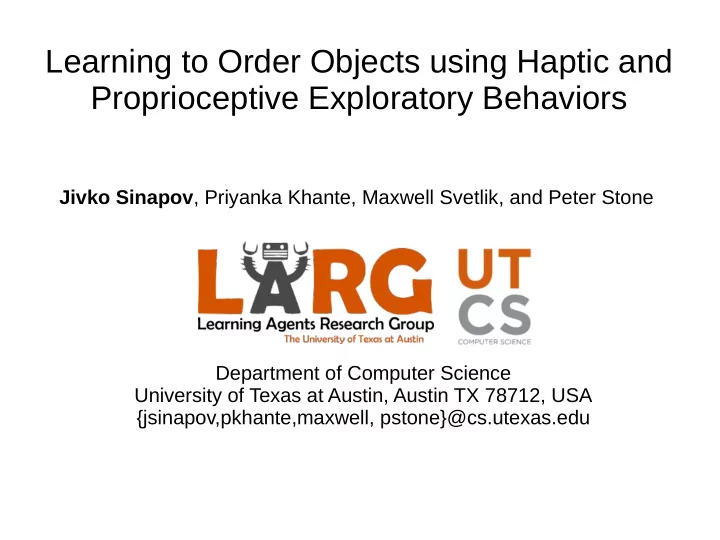

Learning to Order Objects using Haptic and Proprioceptive Exploratory Behaviors Jivko Sinapov , Priyanka Khante, Maxwell Svetlik, and Peter Stone Department of Computer Science University of Texas at Austin, Austin TX 78712, USA {jsinapov,pkhante,maxwell, pstone}@cs.utexas.edu
Building-Wide Intelligence Project: http://www.cs.utexas.edu/~larg/bwi_web/ 2
Building-Wide Intelligence Project: http://www.cs.utexas.edu/~larg/bwi_web/ 3
Building-Wide Intelligence Project: http://www.cs.utexas.edu/~larg/bwi_web/ 4
Motivation: Grounded Language Learning Robot, fetch me the green empty bottle 5
Object Category Recognition in Robotics Sridharan et al . 2008 Collet et al . 2009 Lai et al . 2011 Rusu et al . 2009 6
Object Category Learning in Robotics Thomason, J., Sinapov, J., Svetlik, M., Stone, P., and Mooney, R. (2016). Learning Multi-Modal Grounded Linguistic Semantics by Playing I, Spy Robotics and Vision 3 Session 7
Now, when and where does this fail... Consider the word, “weight” - how should it be grounded? 8
How do humans ground such words? Sample Montessori toys designed to teach children about the ordinal properties of object weight, height, and size 9
Object Ordering in Psychology 10
Object Orderings in Human Environments 11
Problem Formulation ● Order Recognition: what property is a given series of objects ordered by? “height” “width” 12
Problem Formulation (2) ● Order Insertion : given an object series, insert a new object into the correct position series test object 13
Three-Stage Approach Stage 1: Object Exploration Stage 2: Unsupervised Order Discovery . . . . Stage 3: Semantic Grounding . . . . weight width height 14
Stage 1: Object Exploration 32 common household and office items The objects vary along three ordinal properties: 1) Weight 2) Width 3) Height 16
Exploratory Behaviors 17
Video 18
Video 19
Video 20
Haptic and Proprioceptive Feature Extraction . . . . . . Joint Efforts (Haptics) Joint Positions (Prorioception) 21 Time
Haptic and Proprioceptive Feature Extraction . . . . . . Joint Efforts (Haptics) Joint Positions (Prorioception) 22 Time
Haptic and Proprioceptive Feature Extraction . . . . . . Joint Efforts (Haptics) Joint Positions (Prorioception) 23 Time
Stage 2: Unsupervised Order Discovery Sensory Modalities haptics proprioception grasp lift hold Behaviors lower drop push press 24
Unsupervised Order Discovery Example with Synthetic Data Object order with highest Input Relational likelihood using the method of Count Matrix [Kemp and Tennenbam, 2008] 26
Example Relational Count Matrix with the Press action and Haptic features Similarity between objects i and j in the press-haptic sensorimotor context 27
Resulting Order ( Press behavior and Haptic modality) The number corresponds to the object's height in millimeters 28
Stage 2: Unsupervised Order Discovery Sensory Modalities haptics proprioception grasp lift Behaviors hold lower drop push press 29
Stage 3: Order Grounding Stage 30
Order Grounding Example: “height” Positive Examples: Negative Examples: . . . . . . 31
Object Order Representation Training Example: . . . . Object Orders Discovered During Stage 2 32
Object Order Representation Training Example: . . . . Object Orders Discovered During Stage 2 33
Object Order Representation Training Example: . . . . Object Orders Discovered During Stage 2 34
Object Order Representation Training Example: x 1 . . . . Object Orders Discovered During Stage 2 35
Object Order Representation Training Example: x 1 . . . . Object Orders Discovered During Stage 2 36
Object Order Representation Training Example: x 1 x 2 . . . . Object Orders Discovered During Stage 2 37
Object Order Representation Training Example: x 1 x 2 x n . . . . . . . . Object Orders Discovered During Stage 2 38
Results: Order Recognition 39
Sample Learned Decision Trees weight width height Hold Haptics Grasp Proprioception Press Proprioception Lower Haptics Press Haptics Lift Haptics 40
When does the robot make mistakes? 41
When does the robot make mistakes? difficult easy 42
When does the robot make mistakes? difficult easy 43
Object Order Insertion Results 44
Object Order Insertion Results 45
Object Order Insertion Results 46
Object Order Insertion Results 47
Conclusion ● A behavior-grounded framework for learning object ordering concepts ● The robot grounded three ordering concepts, “weight”, “height”, and “width” ● Future Work: – Active action selection – Learn object ordering concepts in conjunction with object categories, pairwise object relations, etc. – Learn from humans (for a preview, see our next talk at Robotics and Vision III ) 48
Thank you! Jivko Sinapov Priyanka Khante Maxwell Svetlik Peter Stone http://www.cs.utexas.edu/~larg/bwi_web/ 49
Recommend
More recommend